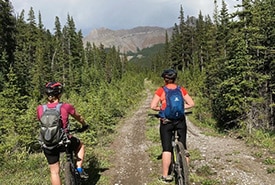Spending time in nature is key for our mental and physical health. But as more people seek a connection to the outdoors, the pressure on natural landscapes and wildlife grows. From hiking and biking to snowmobiling and skiing, outdoor recreation is booming across Canada. And with this surge in outdoor activity comes a challenge: how do we enjoy nature without compromising cherished ecosystems or creating conflict?
That’s the question driving “recreation ecology” research that the Nature Conservancy of Canada (NCC) has collaborated on with the Yellowstone to Yukon Conservation Initiative, the University of Northern British Columbia and o…
Spending time in nature is key for our mental and physical health. But as more people seek a connection to the outdoors, the pressure on natural landscapes and wildlife grows. From hiking and biking to snowmobiling and skiing, outdoor recreation is booming across Canada. And with this surge in outdoor activity comes a challenge: how do we enjoy nature without compromising cherished ecosystems or creating conflict?
That’s the question driving “recreation ecology” research that the Nature Conservancy of Canada (NCC) has collaborated on with the Yellowstone to Yukon Conservation Initiative, the University of Northern British Columbia and other partners.
Over six years, researchers studied when, where, how, and how many people are involved in outdoor recreation in western Alberta and eastern British Columbia. We needed to know how activities overlap with each other and with sensitive wildlife habitat.
Nature guides us to think big
Right from the start, we knew we had to work at a broad spatial scale. Wildlife move across valleys, over mountain passes and inside and outside parks to find food, safety, rest and mates. As an avid outdoor recreationist, I recognize this decision-making in my own choices: returning to favourite places or exploring new ones, seeking company or solitude, moving fast or slow. It didn’t make sense to study just one type of recreation, in one season or in one park because that’s not what happens in real life.
 The study area covers western Alberta and eastern British Columbia. (Graphic: Loosen Studio)
The study area covers western Alberta and eastern British Columbia. (Graphic: Loosen Studio)
A new approach to recreation data
Traditional recreation monitoring tools like trail counters and cameras have long been used to measure outdoor activity. But this research goes further: integrating user-generated data from apps like Strava and AllTrails for a fuller picture of recreation patterns. By combining these sources with existing information, we mapped more than 54,000 kilometres of trails and linear features — 27 per cent of which were previously undocumented.
That’s important because accurate information is essential for planning and management. Whether it’s for backcountry search and rescue, reducing conflict with wildlife or planning alternative routes and services, we need to understand where people go and why. Comparing different data types reveals trade-offs in cost, time, sensitivity, scale, seasonality and more.
 Mountain biking in the Rockies includes bear safety. (Photo: Aerin Jacob)
Mountain biking in the Rockies includes bear safety. (Photo: Aerin Jacob)
Our innovative approach allows for seasonal mapping of motorized and non-motorized recreation activities, alongside habitat quality maps for sensitive species at risk of extinction like grizzly bear, mountain caribou and wolverine. These insights are critical for identifying areas of overlap between high recreation use and high-quality wildlife habitat.
The search for solutions
The research highlights how different species respond to recreation. For example, grizzly bears often share low-elevation valley bottoms with hikers and bikers in spring, increasing the potential for human-wildlife conflict. Wolverines, sensitive during their winter denning season, face pressure from high-elevation winter recreation like skiing and snowmobiling. Mountain caribou are particularly vulnerable to human disturbance, especially during the stressful winter season and because it can increase access for predators.
 Researcher collecting data during winter aerial surveys. (Photo: Aerin Jacob)
Researcher collecting data during winter aerial surveys. (Photo: Aerin Jacob)
Climate change adds another layer of complexity, especially in winter. Warmer winters and more precipitation falling as snow brings unpredictability, a shorter snow season and concentrating recreation into smaller areas — further straining wildlife habitats. Understanding these dynamics is essential for developing species-specific guidelines and thresholds for responsible recreation.
From research to action
The goal of this project isn’t just to gather data — it’s to drive positive change. By equipping land managers, governments, Indigenous Nations and communities and recreation leaders with evidence-based tools and recommendations, this and other recreation ecology research informs better planning, management and policy.
Key recommendations include:
- Using a mix of traditional and user-generated tools to monitor recreation;
- Incorporating recreation data from a variety of sources into wildlife habitat models;
- Supporting collaboration among researchers, managers and recreationists;
- Promoting responsible recreation through digital platforms and outreach; and,
- Establishing practices and policies that protect sensitive species from recreation impacts.
Why it matters
Outdoor recreation touches so many aspects of our lives, from health and social to economic and cultural. Wise management and planning is crucial for longevity and coexistence. Without it, increased recreation can unintentionally degrade habitats, disturb wildlife and diminish outdoor experiences for everyone. This has been one of my most rewarding research projects. The results help decision-makers prioritize coexistence in recreation — now and in the future. It’s a model of how science, collaboration and creativity can ensure that when nature thrives, people thrive.